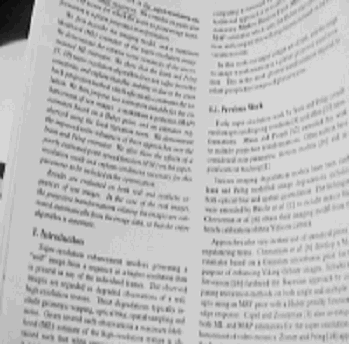 |
Textual Information Access for the Visually Impaired
Ali Zandifar and Changjiang Yang, Ramani Duraiswami,
Larry Davis and Nail Gumerov |
 |
Created On : 03-16-2001

Perceptive Interface and Reality Lab
Introduction
- Approximately 1 million legally blind and 5 million visually impaired people live in the US. Similar proportions elsewhere
- Wearable computer based prostheses could help them access visual information in the environment.
- A significant portion of the available information in the world is
textual
-
Product and pharmaceutical labels
-
Grocery and department store aisle signs
-
Street signs, ATM instructions etc.
-
Goal:
-
Develop a personal reader using off-the-shelf OCR and text-to-speech, wearable computers and cameras.
-
Developing necessary computer vision algorithms.
TOP
Preliminary Prototype and Hardware
- Develop a personal reader that can be used to read magazines and newspapers.
- Direct it to the low vision population and use user input to detect text

-
Color firewire camera with controllable zoom, focus, iris and saturation mounted on a light helmet
- Computer Vision and image processing unit
- Output and User interface( a speech synthesis module and/or display unit)
TOP
Research Issues
-
Identify test bearing region in the image
-
Unwarp text bearing region into front-to-parallel rectangles to provide input to Optical Character Recognition (OCR)
-
Develop dictionaries and strategies OCR on data in a specialized format (warnings, nutritional labels) that have a known format and dictionary
- Stabilization of the video image be stabilized to compensate for motion or jittering by a moving person
- Super-resolution and mosaicking of an image sequence
-
Real-time Camera Control
-
Develop a user-interface suitable for the visually impaired
(bold – currently active research areas)
See individual Links
- Unwarping Text on Curved Surfaces
- Mosaicking
- Super-Resolution Enhancement
TOP
Unwarping Text on Curved Surfaces
-
Using differential geometry based constraints to unwarp the image .
-
On the warped surface:
- Curves have the same length
- Enclosed curves enclose the same area
- Use constraints and regularity of text spacing to unwarp text.

TOP
Mosaicking
-
Images captured by a camera are low resolution.
-
Capturing pieces of a page at high zoom and then stitching the pieces together (“mosaicking”) is a solution
-
To determine the scan protocol:
- Get the rough estimate of Camera zoom with respect to readable font size OCR
- Zoom to the region of interest and auto-focus to remove degradation
TOP
Super-Resolution Enhancement
In super resolution multiple low resolution images (that are slightly displaced) are combined to achieve a high resolution image.
- Subpixel registration of images by phase correlation method.

- Automated super-resolution of image sequences using back-projection and MAP estimator.

TOP




![]()


